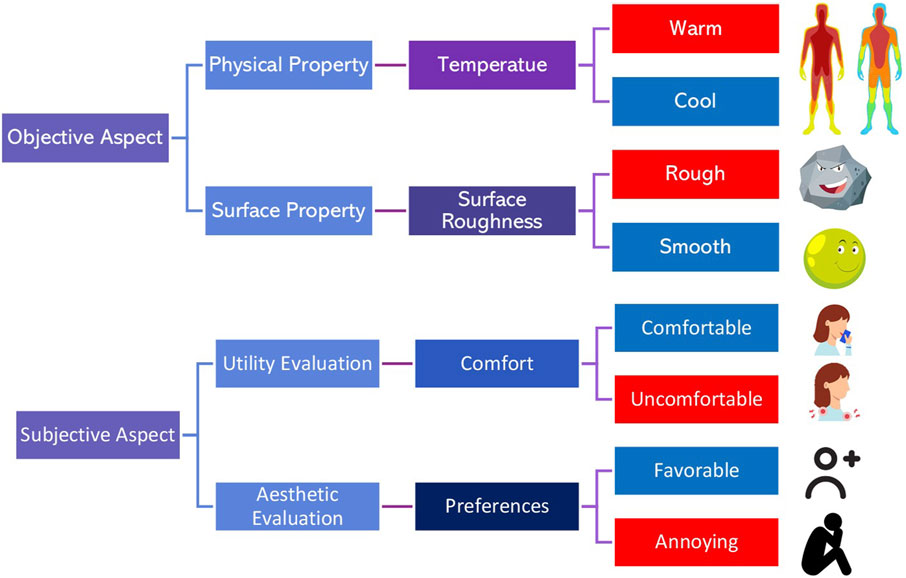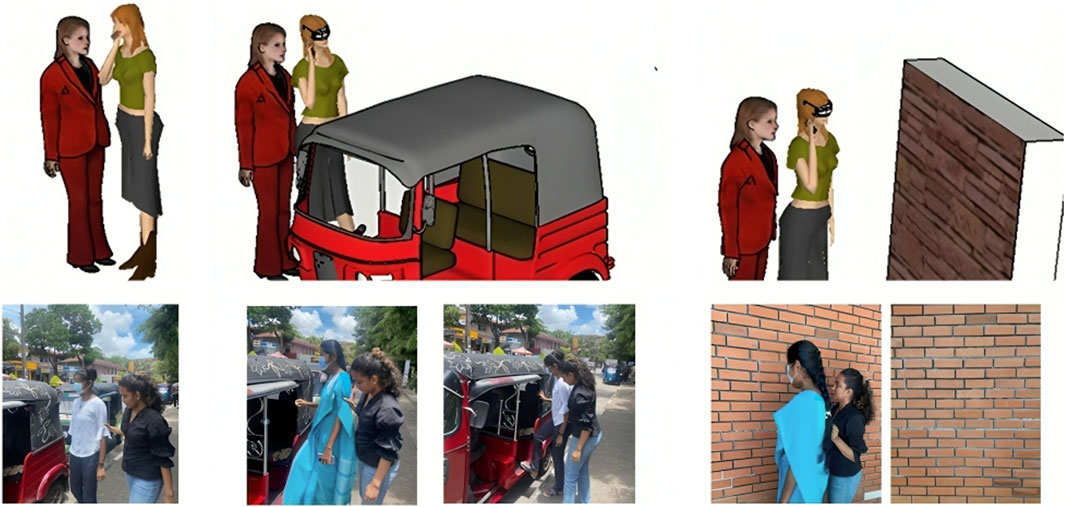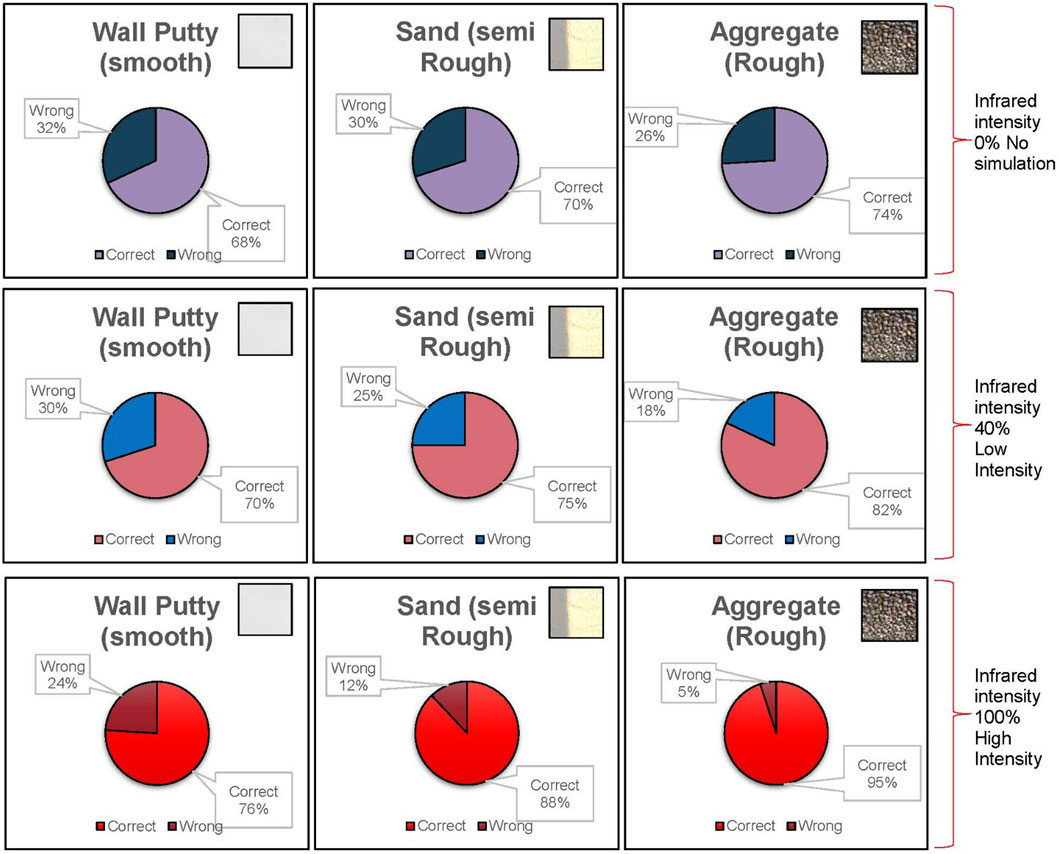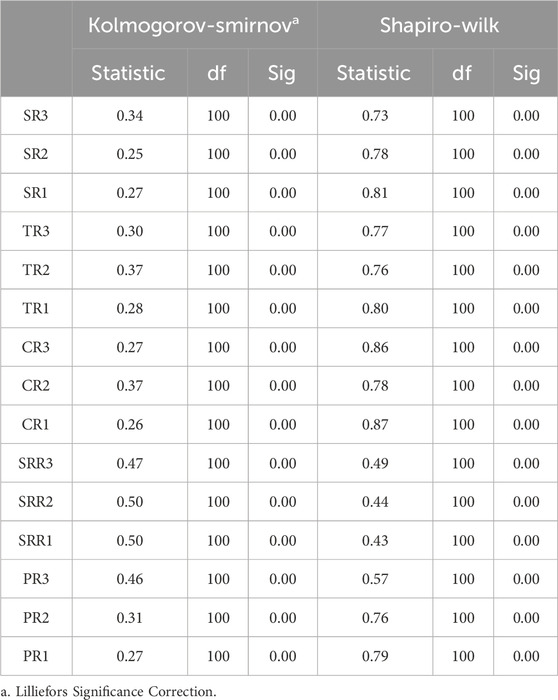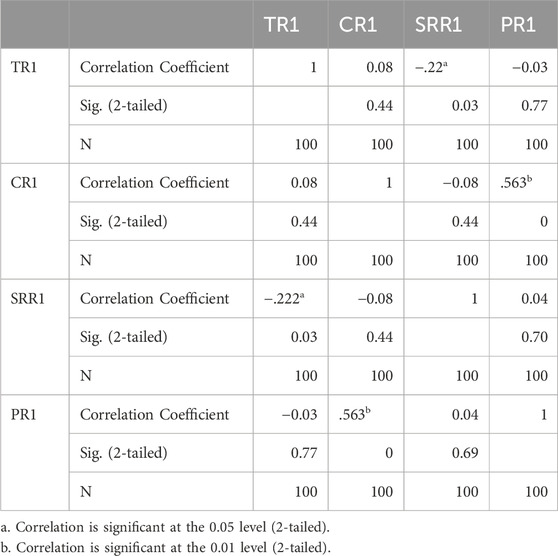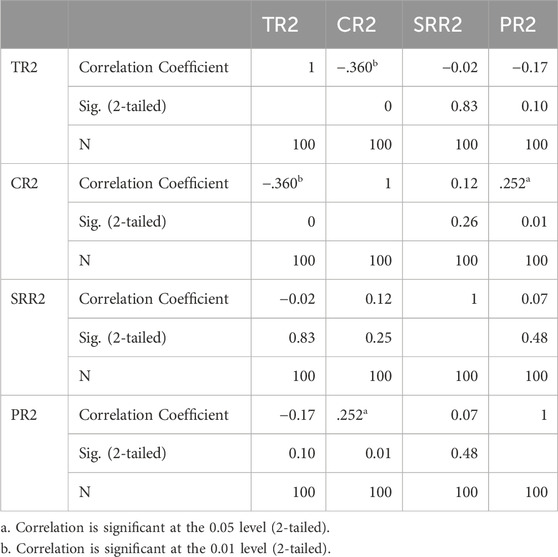- Department of Estate Management and Valuation, University of Sri Jayewardenepura, Sri Lanka
Material texture significantly influences how people perceive built environments, yet empirical evidence supporting its impact on spaciousness perception is limited. This study aimed to explore how people perceive building materials through sense in the absence of visual attention and how texture meanings affect indoor spaciousness perception. Conducted with 160 participants (90 males, 70 females, mean age ±SD: 22 ± 5 years), the study comprised three phases: baseline tactile assessment, blindfolded navigation in a lab and exposure to real-world environments. Findings revealed the skin’s ability to discern textural quality without visual cues, with slightly rough wall surfaces consistently perceived as more spacious. Moreover, the association between wall texture and perceived space varied, with subjective aspects influencing spaciousness in relatively spacious rooms, while objective factors played a larger role in less spacious settings. This study provides insights into sensory referral processes, warranting further investigation into the potential psychological impacts of textures.
1 Introduction
For Exploring prehistory provides vital insights into the roots of human evolution, in early societies, people were used to having textured caves with rough walls (Ramadan et al., 2019). They would have touched and interacted with materials such as rocks, animal hides, plant fibres and more for millions of years. Contemporary humans, despite residing in non-cave environments, share common sensory experiences shaped by the diverse building materials and textural qualities present in modern constructed spaces.
For the examples, the study conducted by Marschallek et al. (2023) utilized functional near-infrared spectroscopy (fNIRS) to investigate the neural correlates of active fingertip exploration and subsequent aesthetic judgments of material surfaces. Results showed that smoother textures were rated as more pleasant, with corresponding increased activation in contralateral sensorimotor areas and left prefrontal regions. Metzger et al. (2022) has investigated the perceptual haptic representation of materials arises from the efficient encoding of vibratory patterns felt during tactile exploration. They trained a computer program to recognize these vibrations and found it could tell materials apart accurately and results show that the way the computer learned to understand materials was similar to how our brains do it. (Wong and Ng, 2021; Garcia and Brown, 2018; Garcia and Rodriguez, 2019; Lee and Kim, 2018) have investigated how haptic perception influences people’s experiences in urban landscapes and found that tactile qualities of urban materials play a significant role in shaping perceptions of safety, comfort and aesthetic appeal. It is found that materials with tactile diversity and sensory richness are preferred for enhancing the user experience and promoting social interaction in public environments (Szczesniak, 1963). Furthermore, (Chen and Li, 2022; Ye and Li, 2023). (Garcia and Rodriguez, 2019; Kim and Lee, 2019; Tan H. and Wong, 2016) have found that tactile qualities and material selection contribute to people’s engagement with built environment, shaping their perception and experience covering a various aspects including atmosphere, user experience, sense of harmony, connection with nature, favouring, spatial perception and behaviour. The studies conducted by (Tiller et al., 2010; Kim et al, 2020; Tan L. and Wong, 2016) examined the relationship between material perception and emotional response in interior design and results highlighted materials with warm textures tend to evoke positive emotions, contributing to a sense of comfort and coziness, enhancing the overall quality of urban spaces. Also, it is found that rough texture evokes feelings of warmth and comfort, while smooth textures are associated with a sense of sleekness (Johnson and Smith, 2016).
Moreover, blind individuals commonly rely on tactile sensations to perceive textural qualities, and previous studies conducted by (Heller, 1989; Taylor and Lederman, 1973; Heller, 2004; Alary et al., 2009; Johnson and Hsiao, 1992; Baumgartner et al., 2015) have extensively examined how the blind community comprehends spatial environments. However, Visual clues (VC) serve as the predominant mode of information extraction within our perceptual framework. Architectural spaces and the overall quality of the built environment are predominantly apprehended through visual cues.
Nevertheless, there exists a gap in the current body of research, as no study has thoroughly explored how individuals with normal vision perceive building material’s textures without visual cues. Not only that, until now the theoretical exploration of building materials has predominately focused on the fundamental characteristics of material texture (Szczesniak, 1963), the technology behind their composition (Borch, 2004) and their non-visual expression applications (Liu et al., 2019).
Therefore, despite numerous experiments conducted on blind individuals demonstrating their ability to sense and navigate through spatial environments, little attention has been directed toward investigating the perceptual capabilities of sighted individuals in the absence of visual information. This research aims to address this gap by specifically focusing on individuals who regularly interact with typical architectural spaces.
Bridging this research gap, the study explores the relationship between wall textures and spatial perception using a multi-sensory approach, providing valuable insights into how architectural elements influence human experiences which is crucial for informing architectural design practices aimed at creating environments that promote wellbeing and satisfaction. Ultimately findings challenge the reliance on visual elements in architectural design, proposing that texture can be strategically used to enhance the perception of space. By understanding the psychological impact of texture, architects and designers can create more inclusive environments that lead to designing spaces that feel more spacious without increasing physical dimensions, potentially reducing material use and construction costs, including those with visual impairments.
Furthermore, incorporating textures that enhance the perception of spaciousness in interior design can significantly contribute to the sustainability. By using materials that create a sense of larger space within smaller rooms, architects and designers can reduce the need for expansive floor plans. This approach not only optimizes the use of available space but also leads to lower energy demands for heating, cooling and lighting as smaller, well-designed spaces require less energy to maintain comfortable conditions. Consequently, leveraging texture to influence spatial perception aligns with sustainable building practices, promoting energy efficiency while minimizing the environmental impact of construction and operation.
2 Materials and methods
To facilitate the aim of this study, a unified experiment was structured into three sequential parts and it aimed to explore the consistency of findings across varied experimental conditions while bridging the gap between controlled laboratory settings and real-world applications.
2.1 Participants
There were three studies conducted in this research and recruited participants separately for each study. In Study 1, fifty healthy participants (20 males, 30 females, mean age ±SD: 22 ± 5 years) were initially involved. However, twelve participants were subsequently excluded due to their preconceived notions about the interior of the box, as detailed below. Subsequently, Study 2 enlisted the participation of a hundred new individuals (64 males, 36 females, mean age ±SD: 22 ± 5 years). Study 3 involved the voluntary participation of ten students. The predetermined sample size for each experiment (n = 12) was based on the considerations of previous similar studies (Julious, 2004).The experimental protocol received approval from the Ethics Review Committee of the Faculty of Medical Sciences, University of Sri Jayewardenepura. The study adhered to the ethical standards outlined in the declaration of Helsinki. Prior to each experiment, all participants provided written informed consent and followed the guidelines set by the Ethics Review Committee.
2.2 Experimental design
Study 1, focused on the textural sensation of the hand towards building materials. Figure 1 depicts the experimental setup employed and three boxes were constructed using distinct building materials characterized by varying textural qualities: Wall putty (smooth finish), Sand (Semi-Rough Finish), and Aggregate ±20 mm (rough finish), along with a 250-W infrared light bulb. Stimulation was administered at three different intensity levels, spanning a range from off to high, by connecting the bulb to one of three dimmers. The dimmer switches were initially set at 0% (no stimulation), 40% (low intensity), and 100% (high intensity) of their range and remained unchanged throughout the study. To ensure consistency, the depth of the hand was marked before the study, emphasizing participants not exceeding the designated box depth. Participants who reported touching the box walls were excluded from the study. The participant’s most capable hand (right/left) was placed one foot inside the box. Before putting the hand, one foot was marked on the participant’s hand by using a hair band. A standardized questionnaire addressing the textural quality of the box touched by participants was administered after the study and collected data was analysed using descriptive analysis.
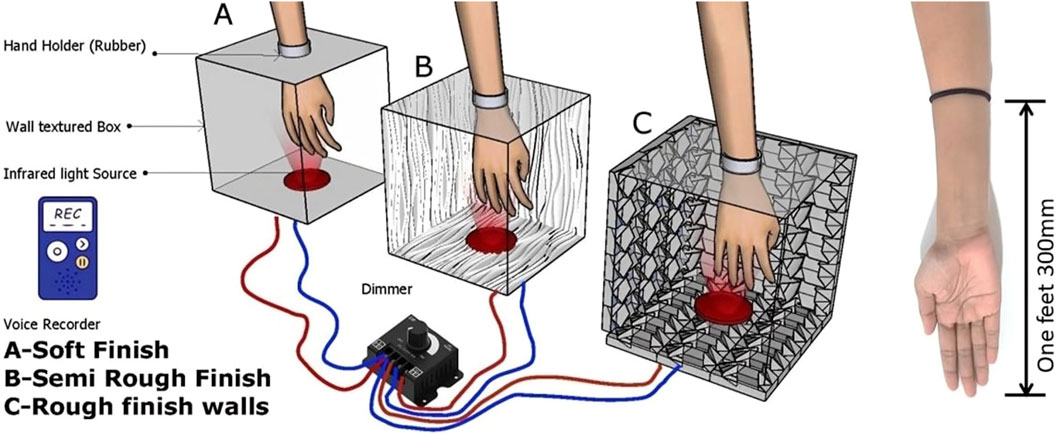
Figure 1. study 1; baseline tactile assessment. (A) Soft finish (B) semi rough finish (C) rough finish walls.
In study 2, we built three rooms of the same size (3′X3′X8′) with three different textural qualities such Wall potty (smooth finish), Sand (Semi Rough Finish) and Aggregate ±20 mm (rough finish) shown in Figure 2 which aimed total body perception of the textural quality. A door was created for each room with the same textural quality and then placed next to each other (Tan L. and Wong, 2016). After making the mockup all three boxes were located in a hidden open hall near the main entrance of the building to make participants alien to the room. Then participants gathered outside of the hall to measure their blood pressure and see any complications. If the blood sugar level is normal and the participants are ready to participate in the survey their eyes were closed by using an eye mask. And they were directed to different textured rooms. Participants were randomly put inside the textured room and given the questionnaire by using a voice recorder to reduce any complications during the survey. And their answers were recorded and analysed. We did not use any infrared lights or energy ray simulations thinking of the health repercussions of the procedure. But we did the testing during daytime when the average temperature was 74°F–90°F and the humidity ranged between 69% and 75%. However, all other environment parameters were tested both inside and outside of the test specimens by using probes. In the first part of this study, we asked to participants to rate the space of three different rooms. And in the second part of this study, as mentioned in the objectives, to unravel the relationship between observer interpretation of material texture spatial qualities and its effects on perception, we examined how building material’s associational meaning impacts an individual’s perceptual spaciousness. To find the relevant terms for describing the associational meaning of texture, the author has reviewed (Winkenbach and Salesin, 1996; Li, 2014; Elkharraz et al., 2014; Leder et al., 2004; Sun et al., 2013; Carbon and Jakesch, 2012) references that describe various properties of material texture. Based on the literature (Wang et al., 2020) 8 relevant semantic scales were selected. All the participants from the first part of study 2 were used and asked to rate the scene using 8 semantic scales as shown in Figure 3. The author has used a five- level scoring system: 1 for extremely left-end adjectives, to 5 for extremely right-end adjectives.
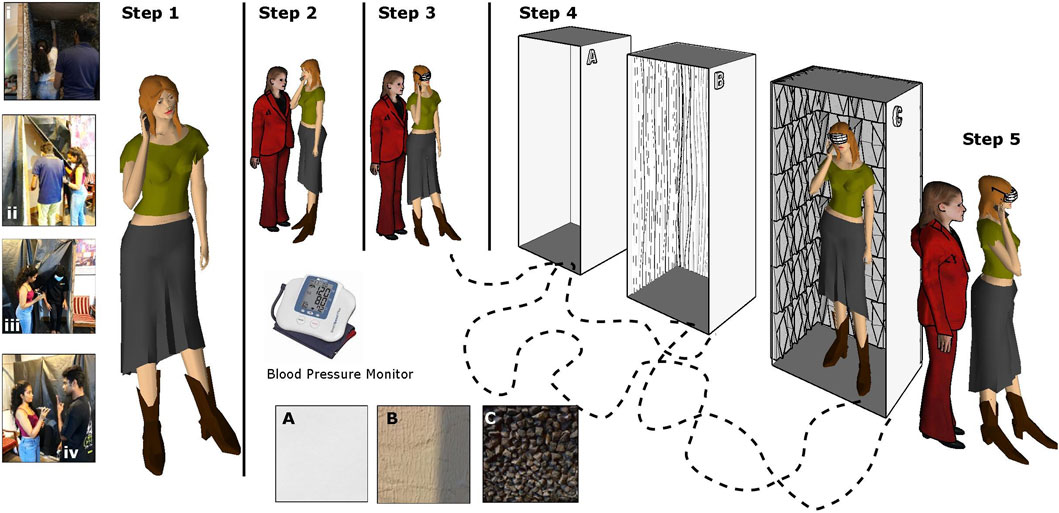
Figure 2. Study 2; Blindfolded navigation in a lab setting; (A) Smooth finish, (B) Semi rough finish, (C) Rough finish.
In study 3. in addition to the comprehensive behavioural tests conducted within controlled environments, a supplementary study was conducted to explore the tactile and visual perceptions of individuals in real-world settings. This observational study aimed to capture the subtle nuances experienced during transitions among spaces featuring walls with distinct textures, specifically rough, textured to smooth surfaces. A total of ten real-world locations were selected to ensure a diverse representation of wall textures, including but not limited to public buildings, commercial spaces and residential areas. The first participants were blindfolded and transported to the location without a visual clue of the space as shown in Figure 4. Participants engaged in naturalistic observation, facilitating an exclusive focus on tactile and auditory senses during transitions. Insights were collected through open-ended participant reflections, capturing their impressions, feelings and any notable observations concerning the perceived shifts in wall textures. visual and sound recorders were utilized to aid in documenting these reflections.
3 Results
In study 1, focused on whether the human hand can sense the building material without any visual clue. Hence, we created three boxes with three different surface materials as explained in the methodology section. And then blindfolded participants were asked to put their hands inside the box. According to the results shown in Figure 5, the human hand can identify the building surface materials used to build the surfaces of the box without any visual clue. The provided tables present accuracy rates for correct and incorrect judgments in the evaluation of three construction materials (Wall Putty, Sand, and Aggregate) across different surface conditions, namely smooth, semi-rough, and rough. In table A, the accuracy percentages for Wall Putty (smooth), Sand (semi-Rough), and Aggregate (Rough) are 68%, 70% and 74% for correct judgments, respectively, with corresponding incorrect judgment rates of 32%, 30% and 26%. The first stage was without any thermal simulation or infrared rays to simulate the heat intensity of the apparatus. The second stage of study 1 is with infrared simulation and has given some signals to the skin to understand the surface of the building materials without any visual clue. Table B indicates slightly improved accuracy with percentages of 70%, 75% and 82% for correct judgments and 30%, 25% and 18% for incorrect judgments across the same material-surface combinations. Finally, table C demonstrates further enhancements in accuracy, revealing correct judgment rates of 76%, 88% and 95%, and incorrect judgment rates of 24%, 12% and 5% for Wall Putty (smooth), Sand (semi- Rough), and Aggregate (Rough), respectively. These results highlighted that the human hand can accurately identify the building surface materials used to build the surfaces of the box without any visual clue.
In study 2, focused on the effect of the different wall textures on human perceived spaciousness and the degree of influence dependent on the associated meaning of material texture without visual cues. The first part of study 2, tested whether the three different wall textures can influence the observer’s perception of spaciousness. The Kruskal Wallis test was performed to examine the differences of spaciousness between rooms at varying wall textures and results shown in Table 1 indicated that there were statistically significant differences (p < 0.00) between the three rooms such; Wall potty (smooth finish), Sand (Semi Rough Finish) and Aggregate ±20 mm (rough finish).
Since the Kruskal-Wallis test indicates significant differences among the three rooms, post-hoc test (pairwise comparisons) was performed to identify which wall texture differs. As Table 2, the results show the spaciousness in rooms with aggregate (Room C) and wall potty (Room A) and also rooms with aggregate (Room C) and Sand (Room B), were highly significantly different (p < 0.00), indicating that Room C had a significantly lower spaciousness rating compared to Room A and Room B. However, there was no significant different with Sand (Room B) and Wall potty (Room A). Therefore, this lack of significant difference suggests that participants perceived the spaciousness of Room A and Room B similarly. Given these results, Room B’s perception as the most spacious can be attributed to the fact that it was not significantly difference from Room A in terms of spaciousness, yet it was significantly more spacious than Room C. Therefore the pairwise comparison evidence supports the conclusion that Room B (Sand-Semi Rough Finish) had the most favourable spaciousness rating among the three rooms.
The results from the first part of study 2, reveal that the textural impact on perceptual spaciousness varies depending on the type of building material texture. However, these variations were obtained without the relying on the visual cues. Therefore, it was evident that texture perception evokes the associational meaning of the building materials. As mentioned in the methodology section, a second part of study 2 was conducted. The normality test was conducted to assess the distribution of the variables at the significant level (α) of 0.05. Since data was not normally distributed as shown in Table 3, Spearmen’s correlation analysis was used separately for three rooms, Wall potty (smooth finish), Sand (Semi Rough Finish) and Aggregate ±20 mm (rough finish) and the results are shown in Tables 4–6 respectively.
As per Table 4, there was a moderate negative correlation between temperature (Temp) and surface roughness (SR) which is shown as statistically significant (p < 0.05), indicating that as temp decreases, SR tends to increase. Also, there was a strong positive correlation between comfort (Com) and preference (Pref) which is shown as statistically significant (p < 0.05), indicating that as comfort increases, preference tends to increase. However, other Correlations between the variables were not statistically significant.
Table 5 shows, in Room B, Temp was negatively correlated with Comfort, suggesting that lower temp was associated with a lower level of comfort at highly statistically significant (p < 0.05). Comfort was positively correlated with preference, indicating that higher comfort is associated with higher preference at highly statistically significant (p < 0.05). However, the relationship between temperature and preference approaches significance, indicating a potential trend where lower temperatures are associated with lower preference. Although other Correlations between the variables were not statistically significant.
Table 6, In Room C, There was a significant negative correlation between comfort and surface roughness (SR), suggesting that as comfort decreases, surface roughness tends to increase, highly significant positive correlation between comfort (Com) and preference (Pref), indicating that higher comfort is associated with higher preference and significant negative correlation between surface roughness (SR) and preference (Pref), suggesting that as surface roughness increases, preference tends to decrease. However, correlations between temp and other variables are not statistically significant.
Study 3 provided tangible evidence of participants discerning wall texture differences during blindfolded transitions. Photographic documentation enhances the credibility and visual impact of the findings. We gathered data as mentioned in the methodology and the results revealed that individuals were able to sense variations in wall textures during transitions between spaces with different tactile qualities. Participants consistently reported heightened awareness of their surroundings when blindfolded, emphasizing the reliance on non-visual sensory cues. The qualitative reflections highlighted the participants’ ability to distinguish between rough, textured, and smooth surfaces based on sense and auditory cues, showcasing a heightened sensitivity to the nuances of their environment. The findings significantly enriched the research by offering a practical validation of the findings observed in the controlled laboratory setting and it underscored the importance of non-visual sensory modalities in shaping individuals’ perceptions of their environment, particularly during transitions in real-world settings. Moreover, the study sheds light on the adaptability of human sensory systems, showcasing the capacity to rely on alternative cues when visual information is restricted.
4 Discussion
According to the above results, it is suggested that the type of wall texture significantly influences the perceived spaciousness of indoor spaces. Specifically, Room B with Sand (Semi Rough Finish) contributed to a heightened sense of spaciousness. Interestingly, Room A with Wall Putty (smooth finish) was perceived similarly to Room B, indicating that a smooth wall texture did not significantly diminish the perceived spaciousness compared to the semi-rough texture of Sand. In contrast, Room C with Aggregate (rough finish) was consistently rated as having significantly less spaciousness compared to both Room A and Room B. This suggests that rough wall textures, such as Aggregate, may have a constraining effect on the perception of spaciousness.
Moreover, participants who identify sand (semi-rough-finished) walls as comfortable and most favourite tend to be perceived as more spacious, while those who consider aggregate (Rough Finished) walls a high level of roughness which leads to decreased comfort and preference tend to be less spacious. The room with wall putty (Smooth finished) was spacious but had less perceived spaciousness than Room B (Semi-rough) among participants who associated the smoothness of the wall putty with a higher temperature. The higher temperature could have led to reduced sense of spaciousness, as previous studies suggests that warmer environments may feel more enclosed or confining (Van Hoof, 2008; Tiller et al., 2010). Conversely, Room B with its semi-rough sand texture, was perceived as more spacious where lower temperatures were associated with a higher level of comfort, and it contributed to the perception of increased spaciousness. It is evident that the perception of spaciousness is influenced by the associational meaning of material textures.
The study conducted by Wang et al. (2020) investigated the influence of wall materials on perceived spaciousness in an indoor environment. They found that the effect of texture on perceptual spaciousness varies depending on factors such as the type of material texture and room size. Moreover, they indicated that the perception of spaciousness is influenced by the observer’s associational meaning of material texture. Our study 2, while consistent with this study conducted by Wang et al. (2020) in suggesting that different texture walls and the observer’s associational meaning of textures can indeed impact the perception of space, uniquely isolates the effect of material texture, independent of room size. By controlling for room size and concentrating exclusively on material texture, our study provides a more nuanced understanding of how texture alone influences perceived spaciousness. This approach enables a deeper exploration of the psychological and sensory mechanisms at play, thereby advancing the understanding of material texture as a distinct and influential factor in spatial perception.
Similarly, the study conducted by Stamps, 2006 examined the impact of wall textures on perceived spaciousness. However, unlike their study, where rough walls were associated with increased spaciousness, this study found that rough walls made rooms less spacious while semi-rough walls made rooms more spacious.
While previous studies were done by (Stamps, 2006; Castell et al., 2020; Oberfeld et al., 2010; Coşgun, Yıldırım, and Hidayetoglu, 2022; Bokharaei and Nasar 2016) have extensively explored factors such as wallpaper patterns, lightness of ceiling, floor, colours, room size, window size and amount of furniture in relation to perceived spaciousness, this study provided unique insights into the role of wall textures in shaping perception of space.
5 Conclusion
This study delved into the relationship between wall textures and perceived spaciousness, employing controlled experiments to explain key findings. Firstly, it was discovered that rooms with semi-rough wall finishes were consistently perceived as more spacious compared to those with smooth or rough finishes, highlighting the nuanced impact of texture on spatial perception. In contrast to smooth finishes, which may present a potentially constrictive appearance, or rough finishes, which can create a sense of harshness and enclosure, semi-rough textures offer an intermediate level of tactile and visual variation. This intermediate texture introduces sufficient depth and complexity to the surface, which can enhance the perception of spatial openness.
Such findings underscore the significance of textural choice in environmental design, indicating that the strategic selection of wall finishes can effectively augment the perceived spaciousness of interior environments. This approach not only has implications for improving spatial perception but also suggests potential benefits for sustainability by potentially minimizing the necessity for physically larger spaces, thereby supporting more efficient and environmentally conscious architectural practices.
Additionally, participants demonstrated an ability to accurately sense variations in wall materials without visual cues, suggesting a tactile sensitivity that contributes to the overall perception of space. These findings provide designers with valuable insights, emphasizing the importance of thoughtful material selection in spatial design to optimize occupants’ comfort and wellbeing.
Moreover, the study underscores the potential implications for architectural practice, offering recommendations for creating more comfortable and inviting indoor environments. Designers can leverage the findings to strategically select wall textures that enhance perceived spaciousness and contribute to a positive user experience. Furthermore, the exploration of material texture’s influence on spatial perception opens avenues for further research, particularly in understanding the long-term effects of exposure to specific textures on occupants’ overall wellbeing. By continuing to investigate these relationships, designers can develop evidence-based guidelines for promoting psychological health and comfort through thoughtful material design in architectural spaces.
Data availability statement
The raw data supporting the conclusions of this article will be made available by the authors, without undue reservation.
Ethics statement
The studies involving humans were approved by Ethics Review Committee of the Faculty of Medical Sciences, University of Sri Jayewardenepura. The studies were conducted in accordance with the local legislation and institutional requirements. Written informed consent for participation in this study was provided by the participants’; legal guardians/next of kin. Written informed consent was obtained from the individual(s) for the publication of any identifiable images or data included in this article.
Author contributions
AK: Conceptualization, Data curation, Formal Analysis, Investigation, Methodology, Resources, Software, Validation, Visualization, Writing–original draft. CU: Conceptualization, Data curation, Formal Analysis, Funding acquisition, Investigation, Methodology, Project administration, Resources, Software, Supervision, Validation, Visualization, Writing–original draft, Writing–review & editing.
Funding
The author(s) declare that no financial support was received for the research, authorship, and/or publication of this article.
Acknowledgments
The authors acknowledge the Centre for Real Estate Studies, Department of Estate Management and Valuation, University of Sri Jayewardenepura, Sri Lanka for supporting the project.
Conflict of interest
The authors declare that the research was conducted in the absence of any commercial or financial relationships that could be construed as a potential conflict of interest.
Publisher’s note
All claims expressed in this article are solely those of the authors and do not necessarily represent those of their affiliated organizations, or those of the publisher, the editors and the reviewers. Any product that may be evaluated in this article, or claim that may be made by its manufacturer, is not guaranteed or endorsed by the publisher.
References
Alary, F., Duquette, M., Goldstein, R., and Chapman - Neuropsychologia, C. E.undefined (2009). n.d. ‘tactile acuity in the blind: a closer look reveals superiority over the sighted in some but not all cutaneous tasks. Elsevier. Available at: https://www.sciencedirect.com/science/article/pii/S002839320900133X (Accessed January 5, 2024).
Baumgartner, E., Wiebel, C. B., and Gegenfurtner - Vision research, K. R. (2015). n.d. ‘A comparison of haptic material perception in blind and sighted individuals’. Elsevier. Available at: https://www.sciencedirect.com/science/article/pii/S0042698915000474 (Accessed January 5, 2024).
Bokharaei, S., and Nasar, J. L. (2016). Perceived spaciousness and preference in sequential experience. Hum. Factors 58 (7), 1069–1081. doi:10.1177/0018720816650068
Carbon, C. C., and Jakesch, M.Proceedings of the IEEE (2012). A model for haptic aesthetic processing and its implications for design. Ieeexplore.Ieee.OrgCC Carbon, M JakeschProceedings IEEE, 2012 ⋅ ieeexplore.Ieee.Org. doi:10.1109/JPROC.2012.2219831
Castell, C. von, Sagepub.ComC von Castell, J., and Hecht, H. (2019). Wall patterns influence the perception of interior space. D OberfeldQuarterly J. Exp. Psychol. 2020 journals.Sagepub.Com 73 (1), 29–54. doi:10.1177/1747021819876637
Chen, L., Liu, Y., Li, S., and Sun, W. (2022). Sensory perception mechanism for preparing the combinations of stimuli operation in the architectural experience. Sustainability. 14 (13), 7885. doi:10.3390/su14137885
Coşgun, B., Yıldırım, K., and Hidayetoglu, M. L. (2022). Effect of wall covering materials on the perception of cafe environments. Facilities 40 (3–4), 214–232. doi:10.1108/f-07-2021-0060
Elkharraz, G., Thumfart, S., Akay, D., Eitzinger, C., Henson, B., Ieee.OrgG Elkharraz, I., et al. (2014). Making tactile textures with predefined affective properties. D Akay, C Eitzinger, B HensonIEEE Trans. Affect. Comput. 2013 ⋅ ieeexplore.Ieee.Org 5 (1), 57–70. doi:10.1109/T-AFFC.2013.21
Garcia, E., and Rodriguez, M. (2019). Sensory preferences in interior design. J. Interior Des. 44 (1), 23–36. doi:10.1016/j.foodchem.2020.126743
Garcia, M., and Brown, D. (2018). Tactile sensitivity and material perception. Environ. Plan. B Urban Anal. City Sci. 45 (2), 364–380. doi:10.1051/0004-6361/201833051
Heller, M. A. (1989). Texture perception in sighted and blind observers. Percept. & Psychophys. 45 (1), 49–54. doi:10.3758/BF03208032
Heller, M. A., Watson, D., and Ilies, R. (2004). The role of person versus situation in life satisfaction: a critical examination. Psychological. Bulletin. 130 (4), 574. doi:10.1037/0033-2909.130.4.574
Johnson, K. O., and Hsiao, S. S. (1992). Neural mechanisms of tactual form and texture perception. Annu. Rev. Neurosci. 15, 227–250. doi:10.1146/ANNUREV.NE.15.030192.001303
Johnson, R., and Smith, K. (2016). The influence of texture on architectural perception. J. Environ. Psychol. 40, 186–193. doi:10.1002/etc.3220
Julious, S. A. (2004). Sample sizes for clinical trials with normal data. Statistics Med. 23 (12), 1921–1986. doi:10.1002/sim.1783
Kim, D., Hyun, H., and Park, S. (2020). The effect of interior color on customers’ aesthetic perception, emotion, and behavior in the luxury service. Journal of Retailing and Consumer Servi. 57, 102252. doi:10.1016/j.jretconser.2020.102252
Kim, J., and Lee, S. (2019). Tactile sensations in architectural spaces. Int. J. Archit. Res. ArchNet-IJAR 13 (2), 135–148. doi:10.3389/fpsyg.2019.02135
Leder, H., Belke, B., Oeberst, A., and Augustin, D. (2004). A model of aesthetic appreciation and aesthetic judgments. Br. J. Psychol. 95 (4), 489–508. doi:10.1348/0007126042369811
Lee, Y., and Kim, S. (2018). Tactile sensation and architectural space perception. Archit. Sci. Rev. 61 (5), 370–379. doi:10.1145/3173574.3174075
Liu, S.-M., Bai, Z., Quan, G., and Niebrzydowski, W. (2019)). From “as found” to bush-hammered concrete–material and texture in brutalist architecture. Iopscience.Iop.OrgW NiebrzydowskiIOP Conf. Ser. Mater. Sci. Eng. 2019 ⋅ iopscience 471, 072016. Iop.Org. doi:10.1088/1757-899X/471/7/072016
Li, X. (2014). Application performance of decoration materials on architectural design. Applied. Mech. Mater. 584, 1050–1053. doi:10.7492/IJAEC.2019.023
Marschallek, B. E., Löw, A., and Jacobsen - Neuropsychologia, T. (2023). You can touch this! Brain correlates of aesthetic processing of active fingertip exploration of material SurfacesQ1Neuropsychologia. ElsevierBE Marschallek, A Löw, T JacobsenNeuropsychologia, 2023 Elsevier. doi:10.1016/j.neuropsychologia.2023.108520
Metzger, A., and Toscani - Elife, M. 2022. ‘Unsupervised learning of haptic material PropertiesQ1Elife. doi:10.7554/eLife
Oberfeld, D., Hecht, H., and Gamer - Quarterly Journal of, M. (2010). Surf. Light. Influ. Perceived Room HeightQ1AQuarterly J. Exp. Psychol. Journals.Sagepub.ComD Oberfeld, H Hecht, M GamerQuarterly J. Exp. Psychol. 2010 ⋅ journals.Sagepub.Com 63 (10), 1999–2011. doi:10.1080/17470211003646161
Ramadan, A.E Kamel Ahmed - International Journal of Architecture (2019). Spatial design stimuli to promote wellness through buildings’ design. Clok.Uclan.Ac.UkA Ramadan, E Kamel AhmedInternational J. Archit. Eng. Constr. 2019 ⋅ clok.Uclan.Ac.Uk 8 (4), 1–12. Available at: https://clok.uclan.ac.uk/33056/?template=default_internal (Accessed April 2, 2024).
Stamps, A. E. (2006). Spaciousness and boundary roughness. Journals.Sagepub.ComAE Stamps III, VV KrishnanEnvironment Behav. 2006. journals.Sagepub.Com 38 (6), 841–872. doi:10.1177/0013916506288052
Sun, S. C.ZS Wei - Advanced Materials Research (2013) “The role of building materials development in constructing form evolution,” in Trans tech PublSC Sun, ZS WeiAdvanced materials research. Switzerland: Trans Tech Publications Ltd. Available at: https://www.scientific.net/AMR.772.117 (Accessed January 6, 2024).
Szczesniak, ALINA SURMACKA (1963). Classification of textural characteristicsa. J. Food Sci. 28 (4), 385–389. doi:10.1111/J.1365-2621.1963.TB00215.X
Tan, H., and Wong, L. (2016a). The impact of material texture on urban atmosphere. J. Urban Des. 21 (4), 512–527. doi:10.1145/3173574.3174075
Tan, L., and Wong, P. (2016b). Emotional response to material texture in urban design. Urban Stud. 53 (7), 1449–1464. doi:10.1016/j.arabjc.2021.103339
Taylor, M. M., and Lederman, S. J.RH Gibson - Handbook of perception (1973). n.d. ‘tactual perception of texture’. Books.Google. New York, USA: Academic Press (Accessed January 5, 2024).
Tiller, D., Wang, L. M., Musser, A., and Radik, M. (2010). AB-10-017: combined effects of noise and temperature on human comfort and performance (1128-RP). Q1The J. Acoust. Soc. Am. Available at: https://digitalcommons.unl.edu/archengfacpub/40/.
Van Hoof, J. (2008). Forty years of Fanger’s model of thermal comfort: comfort for all?. Indoor air. 18 (3).
Wang, C., Lu, W., Ohno, R., ComC Wang, M., Lu, W., and Ohno, R. (2020). Effect of wall texture on perceptual spaciousness of indoor space. Z GuInternational J. Environ. Res. Public Health, 2020 ⋅ mdpi.Com 17, 4177. doi:10.3390/ijerph17114177
Wong, T., and Ng, L. (2021). Exploring haptic perception in urban landscapes. Urban Des. Int. 26 (1), 29–46.
Keywords: Archirecture, design consideration, human perception, indoor Spaces, materials, psychological impact, spaciousness, wall texture
Citation: Kudaligama A and Udawattha C (2024) Exploring building materials: human skin as a sensory reference in the absence of visual cues. Front. Built Environ. 10:1431780. doi: 10.3389/fbuil.2024.1431780
Received: 12 May 2024; Accepted: 26 August 2024;
Published: 16 September 2024.
Edited by:
Fan Zhang, Griffith University, AustraliaReviewed by:
Hasim Altan, Prince Mohammad bin Fahd University, Saudi ArabiaXuechen Gui, Wuhan University, China
Copyright © 2024 Kudaligama and Udawattha. This is an open-access article distributed under the terms of the Creative Commons Attribution License (CC BY). The use, distribution or reproduction in other forums is permitted, provided the original author(s) and the copyright owner(s) are credited and that the original publication in this journal is cited, in accordance with accepted academic practice. No use, distribution or reproduction is permitted which does not comply with these terms.
*Correspondence: C. Udawattha, YWt1ZGFsaWdhbWFAc2pwLmFjLmxr
 A. Kudaligama
A. Kudaligama C. Udawattha
C. Udawattha